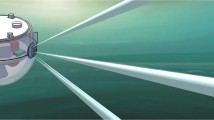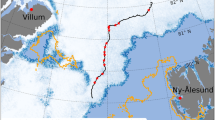Abstract
The Limb Profiler of the Ozone Mapping and Profiler Suite (LP/OMPS) onboard the Suomi spacecraft (NASA/NОАА) has a high sensitivity to the presence of aerosols in the stratosphere and mesosphere at altitudes of 15 to 90 km. Consequently, with this instrument, it is easy to detect, in particular, the Junge aerosol layer and stratospheric and mesospheric polar clouds and atmospheric trails of large bolides. This paper deals with the Suomi limb profiler observations of aerosol trails remaining at altitudes of 30–65 km after rocket launches. In some cases, an aerosol trail of a rocket has been observed for several days, which makes it possible to use these clouds as indicators in the analysis of wind transport in the stratosphere. Sometimes, clouds were observed not only at the launch site, but far from it in the direction of satellite motion. This phenomenon may be caused by the ballistic transport of aerosol clouds: the unburnt particles in the exhaust plume of a carrier rocket, which are formed at altitudes of ~100 km, which have a velocity smaller than the orbital one, but it is high enough for the cloud to pass along the suborbital trajectory and come back to the atmosphere at a distance of thousands of kilometers from the launch site. The effectiveness of observations of aerosol clouds, both natural and artificial, can be enhanced by using a limb profiler with a large number of observational points distributed over the entire horizon.




Similar content being viewed by others
REFERENCES
Hicks, G.T., Chubb, T.A., and Meier, R.R., Observations of hydrogen Lyman alpha emission from missile trails, J. Geophys. Res., 1999, vol. 104, no. A5, pp. 10101–10109.
Kelley, M.C., Nicolls, M.J., Varney, R.H., et al., Radar, lidar, and optical observations in the polar summer mesosphere shortly after a space shuttle launch, J. Geophys. Res., 2010, vol. 115, A05304.
Niciejewski, R., Skinner, W., Cooper, M., et al., Verification of large-scale rapid transport in the lower thermosphere: Tracking the exhaust plume of STS-107 from launch to the Antarctic, J. Geophys. Res., 2011, vol. 116, A05302.
Meier, R.R., Stevens, M.H., Plane, J.M.C., et al., A study of space shuttle plumes in the lower thermosphere, J. Geophys. Res., 2011, vol. 116, A12322.
Newman, P.A., Wilson, J.C., Rossa, M.N., et al., Chance encounter with a stratospheric kerosene rocket plume from Russia over California, Geophys. Res. Lett., 2001, vol. 28, pp. 959–962.
Voigt, Ch., Schumann, U., Graf, K., and Gottschaldt, K.-D., Impact of rocket exhaust plumes on atmospheric composition and climate—an overview, Prog. Propul. Phys., 2013, vol. 4, pp. 657–670.
Chelyabinsk Superbolide. Gorkavyi, N., Dudorov, A. and Taskaev, S., Eds., Springer Praxis Books, 2019.
Brown, P.G., Assink, J.D., Astiz, L., et al., 500-kiloton airburst over Chelyabinsk and an enhanced hazard from small impactors, Nature, 2013, vol. 503, pp. 238–241.
Popova, O.P., Jenniskens, P., Emel’yanenko, V., et al., The Chelyabinsk airburst consortium. Chelyabinsk airburst, damage assessment, meteorite recovery and characterization, Science, 2013, vol. 342, no. 6162, pp. 1069–1073.
Gorkavyi, N., Rault, D.F., Newman, P.A., et al., New stratospheric dust belt due to the Chelyabinsk bolide, Geophys. Res. Lett., 2013, vol. 40, pp. 4728–4733.
Gorkavyi, N., DeLand, M., and Bhartia, P.K., Limb profiler of OMPS/NPP and registration of plumes from bolides and rockets, GSFC/NASA Kaufman Symposium, June 21–23,2016.
DeLand, M., Colarco, P., Kowalewski, M., et al., Dev-elopment of the Multi-Angle Stratospheric Aerosol Radiometer (MASTAR), ESTO Forum, Pasadena, Cal-if., June 12–15,2017.
ACKNOWLEDGMENTS
The author is grateful to the Suomi team for providing him with the data for this study.
Author information
Authors and Affiliations
Corresponding author
Additional information
Translated by E. Petrova
Rights and permissions
About this article
Cite this article
Gorkavyi, N.N. Spaceborne Limb Observations of Artificial Aerosol Clouds. Cosmic Res 58, 86–91 (2020). https://doi.org/10.1134/S0010952520020045
Received:
Revised:
Accepted:
Published:
Issue Date:
DOI: https://doi.org/10.1134/S0010952520020045




